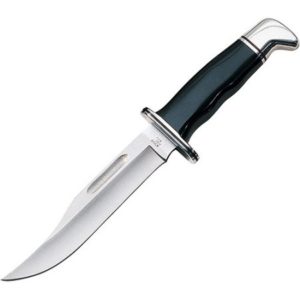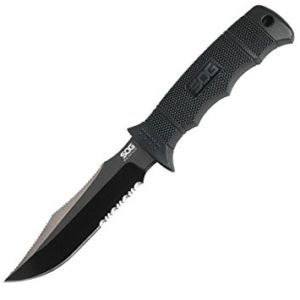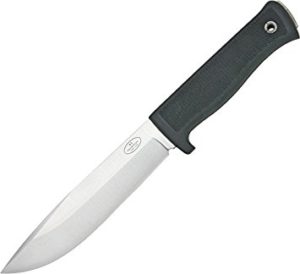No matter what type of outdoor adventure activity you prefer, there’s always the possibility that things can go sideways with little to no warning. Adventure travel is, by definition, unpredictable. We can quickly find ourselves in a survival situation and, when that happens, it’s critical that we have the right tools at our disposal. In these circumstances, a trusty survival knife could make all the difference in a life or death situation.
Survival knives can be used in a variety of situations, including camping, hunting, hiking, and prepping. These knives are designed to be deployed quickly in case of an emergency. River guides, backpackers, hunters, and emergency preppers alike have myriad uses for a quality survival knife. In this article, we’ll review the 9 Best Survival Knives of 2022 and provide the important criteria to consider before buying a survival knife.
1. Buck 119 Special

The Buck 119 Special is classic, proven, and very popular knife. The Buck knife brand has been around for 75 years when they started making knives to send to troops after Pearl Harbor. This knife has an embossed logo on the leather sheath and a stamp on the blade, so some may want to own this knife as a keepsake. This blade is 6″ long and the knife weighs 7.5 ounces.
The 119 Special is a clip blade, meaning it has a crescent tip with a sharper and thinner point than other blade styles. This makes it great for poking holes or other intricate knife work. The blade is made of 420 HC steel which is exclusive to Buck knives.
It combines the durability of high carbon alloys with the corrosion resistance of steel. Their proprietary heat treatment method creates a strong and durable blade that will be a great asset in your survival needs.
2. SOG Seal Pup Elite E37T-K

The SOG Seal Pup Elite is a fixed blade, high quality, and high-performance knife. This knife is on the high end of the SOG Seal products. The Seal Pup Elite was designed for military use and is one of the preferred blades in Special Forces.
It features a 4.85″ AUS8 stainless steel heat treated blade for added strength and durability. The blade is partially serrated with a longer cutting edge and a newly designed clip point shape.
The blade has a 0.19″ thickness, with an overall weight of 5.4 ounces for the knife and is 9.5″ long. The knife has a black finish, which is something unique to the SOG brand- a titanium nitrade (TiNi) coating which is one of the strongest coatings that can be applied to metal. That finish in conjunction with SOG’s proprietary cryogenic heat treatment process ensures that your knife will be incredibly durable.
3. ESEE-4

The ESEE-4 knife is one of the most popular knives available from the ESEE brand. Although there are other knife models available from ESEE such as the 5 and 6, we believe that the slightly smaller size and lighter weight of the 4 make it a more practical and versatile EDC/tactical knife. The blade is stainless steel, 4.5″ long and the full knife only weighs 8 ounces.
This blade is made of durable 1095 carbon steel. ESEE makes it easy to order your knife and customize to your preference, including blade type (serrated or plain edge), removable handles, and various blade finishes (black, desert tan, dark earth, un-coated, stainless steel).
You can also add MOLLE backs to the blade to optimize carrying with your MOLLE webbing. The ESEE knife guarantee cannot be beaten as each knife has a lifetime warranty unconditionally.
4. CRKT M-16 12Z

The CRKT M-16 12Z is rugged, tough, and small survival knife designed for EDC. Columbia River’s Knife and Tools (CRKT) brand have a huge variety of survival knives to fit your needs. The M-16 series has several different choices, but we have chosen to highlight the M-16 12Z Zytel Serrated Edge Tanto Blade Knife. This is a folding knife with a Carson Flipper extension that is unique to CRKT knives.
This extends the blade and also helps to open the blade, and can all conveniently be done with one hand. The patented CRKT AutoLAWKS system is a perfected safety system for their folding knives, allowing you to feel as secure using it as you would with a fixed blade, with the convenience of carrying a folding knife. It ensures that the locking system cannot accidentally close when the blade is open and locked. Along with these excellent safety features, the blade is durable and has a limited lifetime warranty.
5. Fällkniven A1 Fine Edge Fixed Blade

The Fällkniven A1 is a heavy duty, high quality, and top of the line blade designed for heavy use. Fällkniven is a Sweden based knife making company. They are known for high-quality knives at a slightly higher price point. The A1 is an excellent option for a survival knife, it is extremely sharp and the large blade is great for large or small tasks.
It is made of laminated VG10 steel, and the tang extends all the way through to the end of the handle, making a very durable knife and a strong pommel if you need to strike anything. It comes with a black leather sheath that is also durable and easy to carry or attach to packs.
It has excellent balance and a high quality feel with the convex ground blade. This knife is larger than some of the others we’ve reviewed with a 6.3″ blade and an overall length of 11”.
6. Gerber LMF II Survival Knife

Click Here for the Lowest Price
The Gerber LMF II is a top rated, military-inspired, and rugged fixed blade knife. Gerber is a well-known creator of knives and tools. Their Survival Knife was designed by a former military man and was field tested to ensure it was up to their rigorous standards.
Gerber added some unique changes to the design of this knife by adding a pointed stainless steel butt-cap at the end of the blade that can be used to break glass in case of emergency. With this innovation, they only have the tang extend about 3/4 of the way through the handle, purposefully separating it from the stainless steel butt-cap to help with shock absorption and prevent electrical shock when in use.
The knife handle has a comfortable grip with lashing holes. The sheath is thoughtfully designed as well and includes a built-in carbide sharpener and belt attachment. This is a 10″ serrated fixed blade knife, that is both strong and durable.
7. Tom Brown Tracker Knife
Click Here for the Lowest Price
The Tom Brown Tracker knife is a large and extremely versatile survival knife designed specifically for survival situations. This knife from TOPS brand was designed by survival expert Tom Brown Jr. It was featured in the movie “The Hunted”, has been on the cover of Blade Magazine, and is a serious survival knife.
The knife is 11.88″ long, with a 6.38″ blade that is 1/4″ thick. The blade is made of 1095 high carbon alloy with a black traction coating. It was designed to be able to be used for multiple different tasks in a survival situation, such as chop, split, carve, hammer, scrape, saw, engrave, and even break metal wire. This fixed blade knife has multiple parts to the blade.
It has two parts that can carve or chop and, along the spine, there are sawback serrations that mean business and jimping to give added confidence in your grip. The knife also comes with a kydex sheath with a rotating spring steel clip to easily attach it to your pack or hip, weighing 26 ounces total.
8. KaBar Becker Campanion BK2

The KaBar Becker BK2 is a fixed blade knife with a drop point blade and is fully tanged. The blade is 5.25″ with an overall length of 10.5″ for the knife. It is a little heavier than some of the other knives we reviewed at 16 ounces, but that is probably due in part to its durable 1/4″ thick blade made of 1095 cro-van steel.
As the name states, this “campanion” is great to have when camping and enjoying nature. Although not as useful for intricate work, this knife is great for outdoor tasks. The handle feels comfortable in your grip, made of Grivory and comes with a glass-filled nylon sheath.
9. Spyderco Bushcraft G-10

The Spyderco Bushcraft G-10 is a knife designed for the survivalist in the Bushcraft style. Bushcraft is inspired by the Bushmen of the Southern Hemisphere, with the idea of learning how to survive in the wilderness with only a knife. Syperco’s Bushcraft G-10 is a 4″ blade knife that is fully tanged.
The blade is a Scandinavian style with a single bevel grind, made of O-1 high carbon steel. The knife is 8.75″ overall, weighing 7.75 ounces. It has a lanyard hole in the handle and comes with a leather sheath. This knife is an excellent option if you are looking to perform wilderness duties in the traditional Bushcraft style such as whittling, skinning, chopping, and slicing.
—
Buyer’s Guide
When choosing the best survival knife, there are many things to consider including blade types and material. As you might have noticed there is a wide variety in price which is something to consider. We reviewed a lot of good quality budget knives as well as some high-end knives. In this Buyer’s Guide, we are going to focus on the major characteristics to consider when buying a survival knife.
Tang
The first feature we’re going to discuss is tang. Tang is the back part of the blade where it connects to the handle. There are many types of tang, but the main types that we are going to outline here are full tang, half tang, push tang, rat tail tang, and encapsulated tang.
Full Tang
In a knife with a full tang, the metal extends through to the end of the handle. In this design, the metal part of the knife is one solid piece and the two layers of the handle are then pinned onto the blade on each side. These are generally the strongest knives on the market.
Half Tang
Knives that feature partial (or half) tang are generally less sturdy and the blade can become loose over time and with tough use. The metal part of the knife extends along the entire length of the handle but is usually only half the width of the handle.
Push Tang
In a push tang design, the metal part of the knife is pushed into the handle and then secured using glue or epoxy. This type of knife is typically available in either full push or half push varieties. Full push tang knives are designed with the metal pushed all the way to the full length of the handle. Half push tang knives only secure the metal blade down to half the length of the handle.
Rat Tail Tang
In this design, the tang of the knife narrows as you move closer to the butt end of the knife’s handle. At the end, the tang is either threaded or welded to a piece of threaded rod. To finish the design, a bolt or threaded pommel is used to secure the blade to the handle.
Encapsulated Tang
As its name suggests, this tang is entirely smaller than the size of the handle. The knife’s handle is then fitted or molded around the entirety of the blade to create an “encapsulated” feel.
Steel
Most of the best survival knives are manufactured using some type of steel. While there are a huge variety of steels out there, most blades are commonly made of either high carbon steel or stainless steel. Some knife manufacturers go a step further and coat these steels to provide extra strength and improve corrosion resistance. But for all practical purposes, we’ll discuss the pros and cons of stainless steel and high carbon steel here.
Stainless Steel
Stainless steel blades generally contain at least 12 percent chromium. This is important because it improves the blade’s ability to resist rust and corrosion while also making them easier to sharpen. However, stainless steel knives generally need to be sharpened more often because they lose their edge more quickly. This is because stainless steel blades are generally softer than their high carbon steel counterparts.
High Carbon Steel
High carbon steel tends to be tougher and more durable than stainless steel. Carbon is, indeed, the hardest element and, as a result, it produces blades that offer superior edge retention. However, high carbon steel blades don’t include a drop of chromium. This means that they have very poor ability to resist rust and corrosion. High carbon steel blades need to be cleaned and maintained more frequently in order to retain their sharpness.
Blade Patterns
There are also a couple of different blade patterns to consider. The main blade patterns that you’ll see in survival knives are drop point and clip point.
Drop Point
In blades with a drop point pattern, the spine of the blade slopes from the handle to the point, with a convex blade shape. This is most common in hunting knives.
Clip Point
In blades with a clip point pattern, the front third of the blade is essentially “clipped off”. This means that the spine tapers off to the tip and is not as thick. This allows a quicker and deeper stabbing motion.
Additional Features/Uses
Once you’ve really gotten into the technical specifications of knives and narrowed down your choices based on those criteria, it’s useful to look at the additional features that some knives come with. Not all knives are used just for cutting. Some blades come with a fire starter, whistle, or even paracord. These items have specific uses that go beyond what your knife can be useful for. Finding a knife that comes with a few additional items is like bargain shopping. If you can get multiple items for a more affordable price, it’s hard to argue against that.
Frequently Asked Questions
Many people consider a survival knife to be an essential item in a bug out bag. Whatever your reason for carrying a survival knife, make sure you get the best knife for you and your situation. In this section, we’re going to answer some of the most common questions about using and taking care of survival knives.
How often should I sharpen my survival knife?
This obviously depends on how frequently it is used and what it’s used for. If you don’t use your blade often or use it only on softer objects, you may only need to sharpen the blade once or twice a year. Conversely, you can hone your knife blade much more frequently. Honing realigns the microscopic teeth of the blade but doesn’t require the removal of steel to create a brand new edge.
What’s the best way to clean a survival knife?
The first (and arguably best) way to keep your knife clean is to keep it dry. If it does get wet, make sure you dry it as quickly as possible. Then, it’s great to apply a light layer of oil. This is especially important if your knife comes into contact with salt water or another corrosive substance. If you go with a folding survival knife, also take extra time to pay special attention to the hinge where the knife folds into the handle. This is a classic area where dirt, water, and other debris can accumulate and negatively impact the performance of your knife.
Is there a way to get rid of rust accumulated on a knife blade?
There are a variety of methods to remove rust from your knife blade. The first is by using baking soda. In this method, clean the knife with water first and then create a paste using a fair amount of baking soda and water (or lemon juice). Then, apply the paste to the entire length of the blade with a toothbrush before using steel wool or an abrasive sponge to remove the paste and rust along with it. Finish by wiping the blade clean with water and then drying it thoroughly.
Another method you can use to get rust off your blade is by placing it in a vinegar bath. Fill a cup or bowl with white vinegar and place the blade in the “bath” for about five minutes. Be careful not to leave it in the bath for any longer than this, as you risk permanently damaging the blade if you do so. Once you remove the blade from the bath, wipe it down with water and then dry thoroughly. Sometimes, you’ll have to follow this method with the baking soda method to remove heavy accumulations of rust.
Summary
Survival knives can and have been used in a variety of situations. While having a pocket knife on you is handy, sometimes having a reliable survival knife can make a huge difference. Since survival knives have large and sturdy blades, they can be used to whittle, carve, saw, chop, skin game, and for many other uses. We hope you’ve enjoyed this review of the best survival knives of 2019 and we wish you the best of luck finding the right knife and on your next adventures!


